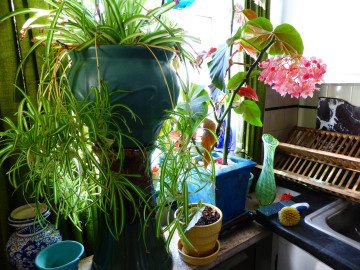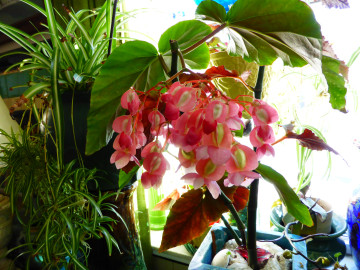Leonard Moorehead, The Urban Gardener: Patience is Virtuous
Saturday, February 28, 2015
Good grief, will the snow ever melt? The cold frames wear snow caps, most perennials are mere suggestions, only the resilient bamboo remains leafy green. Sometimes an icicle crashes into smithereens and takes with it the ivy that clambers up the frozen downspout. Urban gardeners are much more likely to stake out parking spaces than tomatoes. Salt, notable to gardeners as the dire mineral commonly dismissed as necessary, is present on every paved inch, leaching with snow melt directly into our lovingly tended sidewalk flower beds. Once loved and enjoyed, snow has become the endless blind date. If asked, and one hopes not, I’d give a call back number a digit or two off, “I hope I hear from you soon”.
Tradition is turned on its head, age old wisdom questioned. Thaws are forgotten, spaces are heaped with ice, often muddled with litter and age old dilemmas, just where does all that dirt and muck come from? Potholes abound, frost heaves crack sidewalks, and who isn’t tired of wearing long johns day and night? Yet another seed catalog arrives and suffers contempt, no more brilliant Stargazer lilies to taunt, 5 on 1 trees, resplendent with 5 kinds of red, green, stripped, and always lustrous apples perfect for tight urban plots have lost allure, many of us are only too ready to toss in the trowel.
Optimism is persistent though. Just when it can get worse, often streamlined into record breaking cold spells or total snow accumulations, a hint appears. After all, winter storms are no longer named, perhaps advised as a caution by politicians obliged by rhetoric to actually govern, the old adage that politics is the art of removing a dead horse from the street is measured in potholes, invisible drains, and overtime. How about a decent salad? Is there any fresh food not flown in from countries without pesticide or herbicide regulations? Maybe harvested by people curiously close to slavery and less valuable than machinery? Urban gardeners must dig deeply for respite, oops, the inaccessible garden plot has permafrost, steel blades ring and clamor in defeat.
GET THE LATEST BREAKING NEWS HERE -- SIGN UP FOR GOLOCAL FREE DAILY EBLASTHope, eternally human, languishes on the vine. Yet there are ways for the cunning. Carefully comparing the relative merits of tomatoes we drift into reverie. Two by two, we pair off the heirlooms for the ark. Our islands of green joy are snow covered paradises, triumphs of hope over experience. Just about had it with the delay? Perhaps, at the risk of losing the last snow free parking space, we can dig in and guide concept into being.
Start cuttings. Dear old Nana’s cane begonia, the last bit of the family fortune has burst into bloom. You did remember to put a 5 gallon bucket in the cellar last autumn, right? The perlite and peat moss bags remain dry and under cover too. Clay pots remain among us in a plastic world, yet leftover red plastic cups from happier summer picnics need only a quick puncture in the bottom for a nearly free container. Mix up a batch of soil, spread paper down and cover the kitchen table. This timeless ritual propitiates divinities yet described.
Gertrude Louise Niven was a young woman when she brought home then exotic cane begonia. Her parents knew the Civil War, indeed they were advised to have children as antidotes to grief. She used Gorham silver table knives her silversmith husband designed to cut at 45 degree angles the cane begonias leaning towards sunny windowpanes. Each 4 or 5 inch cutting were pinched back to one leaf and a bud. Sometimes she put them in a colored glass full of water to root, others directly into precious art pottery flower pots, re-used generation after generation. Her family were plain folk, “Friends”, who drank hot water at breakfast, no tea or coffee but rather a tablespoon of vinegar. Nana, like the rest of the clan was not wasteful. She was a radical suffragette and tea was the vintage of choice. Superstition might read tea leaves, Nana put them onto the flower pots of beloved pink blooming begonias, leggy and overgrown.
Endurance has merit. Wars, depressions, disease and the West swept away descendants. Time took others, prosperity came and went. Nana outlived them all. She believed, always a window full of blooming begonias, in the parlor a crowded mound of Boston ferns with their curious brown “paws” filled a glamorous pot. When she met her maker, almost 100 years after the beginning, the begonias had already descended onto windowsills far and wide. They bloom twice a year, close to the equinox that reminds them of their tropical origins close to the equator where days are of equal length. Mine is like hers, blooming next to the kitchen sink, a litter of cuttings hopeful for better days crowds the windowsill. No tea leaves for these, coffee grounds are tossed into the garden beds just outside the back door.
Urban gardeners are urged to select plants with heirloom heritage. No GMO here. Rather, heirloom plants found their place in a world where produce was nurtured for taste, flavor, and strength. Transportation over great distances was unknown, Luther Burbank exported new produce and plants from California across the country to people who had never eaten fresh produce out of season. Local varieties, adapted to narrow conditions, were not advertised to generations removed from farms or homelands for whom pictures of red apples reduced a crop of wildly varying types, most for making cider or vinegar, to the classic barometer of the gleaming red apple. It’s news to many urban gardeners that our produce markets are displays of what is supposed to appeal to them rather than accept a blemish or different color. Convention is our bondage.
Browse through seed catalogs. Seek genetic diversity. A hint: heirloom varieties may not conform to ideas of should be but express what is. Taste, flavor, acceptance of various shapes and sizes enters the heirloom garden. Snow may linger but cannot resist longer sunny days. We may not be planting peas on St. Patrick’s Day, we can select though a host of spring favorites who prefer cold wet grounds, the lettuces that never make it to the produce section by names other than “mixed greens”, the beginnings of another season of growth. Nana’s family saw a city grow on and around their lands, the busy traffic on the Post Road does not pause at their granite stone walls any more. Her twice blooming cane begonia, once so exotic is not semper florens. It is however, beloved; and beloved, no snowdrift, no hard frost, no ice slick pavement can hinder nurture and care, belief in the next day towards another joyous spring. It blooms now, just before spring. Crossed fingers? Shame on you.
Leonard Moorehead is a life-long gardener. He practices organic-bio/dynamic gardening techniques in a side lot surrounded by city neighborhoods in Providence RI. His adventures in composting, wood chips, manure, seaweed, hay and enormous amounts of leaves are minor distractions to the joy of cultivating the soil with flowers, herbs, vegetables, berries, and dwarf fruit trees.
Related Articles
- The Urban Gardener: Some Like it Hot, Harvest Time
- The Urban Gardener: Leaves, the Gardener’s Friend
- The Urban Gardener: Cold Frames Endure
- Leonard Moorehead,The Urban Gardener: Minor Bulbs Rule
- The Urban Gardener: Time To Harvest, Time To Plan
- Leonard Moorehead, The Urban Gardener: Harvesting Green Beans + Sunflowers
- The Urban Gardener: Growing Herbs For The Kitchen + Heart
- The Urban Gardener: Cheerful Daffodils
- The Urban Gardener: Rise and Shine
- The Urban Gardener: Harvest Moonshine
- The Urban Gardener: Strawberries and Chives for All
- Leonard Moorehead, The Urban Gardener: Fall Gardens Flush and Full
- The Urban Gardener: Hunker Down, Look Ahead
- Leonard Moorehead, The Urban Gardener: Winter Blooms
- Leonard Moorehead, The Urban Gardener: Icy Grip? Pass the Salt
- Leonard Moorehead, the Urban Gardener: Spring’s Snowy Prelude
- Leonard Moorehead, The Urban Gardener: Seeds in the Snowbed
- Leonard Moorehead, The Urban Gardener: All For Love
- Leonard Moorehead, The Urban Gardener: Bless Garden Catalogs
- Leonard Moorehead, The Urban Gardener: Before and After
- Leonard Moorehead, The Urban Gardener: Wreaths Go Full Circle
- Leonard Moorehead the Urban Gardener: “Scent, First and Last”
- Leonard Moorehead the Urban Gardener: Gardener’s Wish List
- Leonard Moorehead the Urban Gardener: Hollies Forever Holidays
- Leonard Moorehead, The Urban Gardener: Hope Springs Eternal





